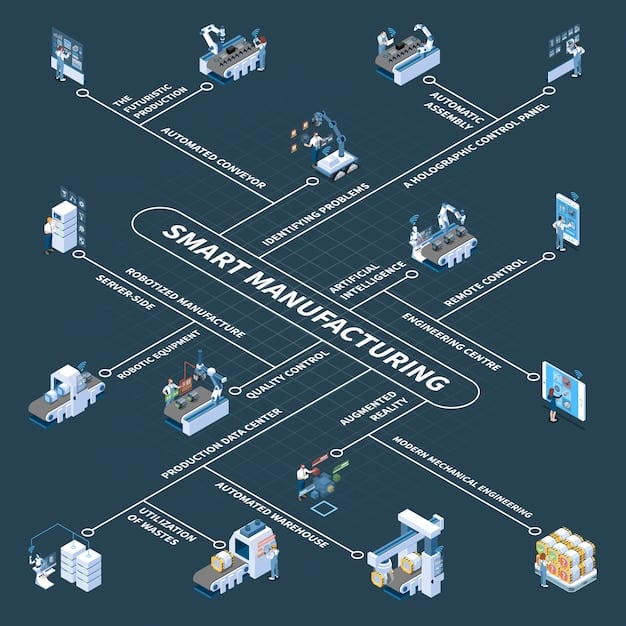Sustainable Business: Meeting Consumer Demand & Eco-Impact

Advertisements
The imperative for businesses to embrace sustainability is rapidly transforming global markets, shifting from a niche concern to a core operational strategy driven by escalating consumer demand and the undeniable urgency of minimizing environmental repercussions.
Advertisements
In an era defined by increasing environmental awareness and evolving consumer values, the discussion around business responsibility has shifted dramatically. Welcome to the significant trend of The Rise of Sustainable Business Practices: Meeting Consumer Demand and Reducing Environmental Impact, a movement reshaping how companies operate and thrive globally.
the shifting paradigm: from profit-first to planet-centric operations
Globally, businesses are recognizing the profound implications of environmental degradation and social inequality. This understanding fuels a critical paradigm shift, moving companies away from a singular focus on profit maximization towards a more holistic model that integrates ecological and social considerations into their core operations.
Advertisements
This evolving perspective positions sustainability not merely as a corporate social responsibility (CSR) add-on, but as a fundamental driver of innovation, risk mitigation, and long-term value creation. Companies that proactively adapt to this shift are finding themselves better positioned to weather future economic changes, attract talent, and build stronger brand loyalty.
the roots of change: consumer and investor pressures
The push for sustainable business practices is not unilateral; it’s a dynamic interplay between internal corporate vision and external pressures. Consumers, particularly younger demographics, are increasingly vocal about their preferences for ethically produced goods and services, demanding transparency and accountability from brands. This consumer power is a significant catalyst.
Simultaneously, the investor community is broadening its view of corporate performance. Environmental, Social, and Governance (ESG) factors are now standard considerations in investment decisions, signaling that sustainability metrics are critical indicators of a company’s financial health and future viability. Investment firms and shareholders are actively seeking businesses with robust sustainability frameworks, underscoring that green is indeed the new gold standard for capital allocation.
- Empowered Consumers: Growing demand for ethical sourcing, reduced waste, and transparent supply chains.
- ESG Investing: Financial markets prioritizing companies with strong environmental, social, and governance performance.
- Regulatory Scrutiny: Increasing governmental regulations and international agreements pushing for greener operations.
- Talent Attraction: A strong sustainability ethos helps attract and retain purpose-driven employees.
Understanding these intertwined forces is crucial for any business aiming to navigate the complexities of modern markets. The businesses that treat sustainability as an integrated strategy, rather than a performative gesture, are the ones likely to thrive in the decades to come, proving that enduring profitability and planetary well-being are not mutually exclusive.
eco-conscious manufacturing and supply chain transformation
The journey towards sustainability often begins at the very root of product creation: manufacturing and the intricate web of the supply chain. This area offers immense opportunities for impact, spanning from the careful selection of raw materials to the efficiency of production processes and the final delivery of goods.
Businesses are now meticulously re-evaluating every stage of their operations to minimize waste, conserve resources, and reduce their carbon footprint. This involves adopting innovative technologies and rethinking traditional linear models of production. The goal is a circular economy where resources are kept in use for as long as possible, extracting maximum value from them while in use, then recovering and regenerating products and materials at the end of each service life.
sustainable sourcing: ethical foundations
The impact of a product often starts long before it reaches the factory floor. Sustainable sourcing involves not only minimizing environmental degradation in the extraction and processing of raw materials but also ensuring fair labor practices and supporting local communities. Due diligence is paramount here, with companies probing deeper into their supply chains to ensure ethical standards are met globally.
Brands are increasingly committing to using recycled, renewable, or responsibly certified materials. This shift reduces reliance on finite resources and supports industries dedicated to sustainable forestry, agriculture, and material recovery. Transparency in sourcing becomes a powerful marketing tool, resonating with consumers who value ethical origins.
optimizing production: energy efficiency and waste reduction
Within manufacturing facilities, sustainable practices translate into tangible operational changes. Significant efforts are being made to reduce energy consumption through the adoption of renewable energy sources, energy-efficient machinery, and smart building management systems. Investing in these technologies initially might seem costly, but the long-term savings and reduced environmental impact often justify the upfront expense.
Waste reduction is another critical pillar. This goes beyond simple recycling to include process optimization that minimizes scrap, repurposes by-products, and innovates packaging to be lighter, recyclable, or compostable. Some companies are even implementing closed-loop systems, where waste from one process becomes a valuable input for another. This holistic approach to efficiency not only helps the planet but can also significantly lower operational costs.
- Renewable Energy Integration: Shifting to solar, wind, or geothermal power for factory operations.
- Water Conservation: Implementing closed-loop water systems and advanced filtration to reuse industrial water.
- Zero-Waste Initiatives: Designing out waste from the start, repurposing materials, and composting organic by-products.
- Lean Manufacturing: Streamlining processes to reduce materials, energy, and time waste.
Embracing eco-conscious manufacturing and supply chain transformation is no longer a niche strategy but a core business imperative. It signals a deep commitment to environmental stewardship and offers a competitive edge in markets that increasingly value corporate responsibility. It presents a dual benefit: reducing environmental impact while also fostering innovation and operational efficiency.
circular economy models: beyond linear production
The traditional linear “take-make-dispose” model of production is proving unsustainable in a world of finite resources and escalating waste. Recognizing this, forward-thinking businesses are increasingly adopting principles of the circular economy, a transformative approach that aims to eliminate waste and the continual use of resources. This paradigm shift involves designing products for durability, reuse, repair, and recycling, ensuring materials remain in use for as long as possible.
This approach moves beyond simple recycling, delving into the fundamental design of products and systems. It requires a systemic change in how businesses conceptualize value, shifting from selling single-use items to providing services, creating modular components, and fostering product longevity. The circular economy is not just an environmental strategy; it is a profound business model innovation offering new revenue streams and increased resource security.
design for durability and disassembly
A cornerstone of the circular economy is designing products with their end-of-life in mind. This means creating items that are built to last, easy to repair, and simple to disassemble when they do reach the end of their useful life. Companies are exploring modular designs, where components can be easily replaced or upgraded, extending the product’s lifespan and reducing the need for complete replacements.
This also includes careful consideration of materials. Products are increasingly designed using single-material components or easily separable materials to facilitate effective recycling, preventing complex mixtures that are difficult to process. The emphasis is on maximizing the ‘material value’ over multiple cycles, significantly reducing landfill waste and demand for virgin resources.
product-as-a-service and closed-loop systems
Innovative business models are emerging that embody circular principles. The “product-as-a-service” model sees companies retain ownership of their products, leasing them to customers and being responsible for their maintenance, repair, and eventual return and recycling. This incentivizes businesses to design highly durable and repairable products, as their long-term profitability is tied to the product’s longevity and ease of recapture.
Closed-loop systems take this a step further, aiming to create production cycles where all waste is turned into new inputs. This can involve companies collecting their used products, processing them, and reintegrating the recovered materials into the manufacturing of new items. Examples range from apparel brands collecting old garments for fiber recycling to electronics manufacturers recovering precious metals from old devices. These systems illustrate a true commitment to resource efficiency.
- Extended Producer Responsibility (EPR): Manufacturers take responsibility for the entire life cycle of products, from design to post-consumer take-back.
- Repair and Refurbishment Services: Offering services to extend product life, fostering customer loyalty and reducing new purchases.
- Industrial Symbiosis: Waste from one industry becomes a resource for another, creating interconnected eco-industrial parks.
- Bio-based Materials: Utilizing biodegradable and compostable materials that safely return to natural cycles.
Transitioning to circular economy models demands significant upfront investment and a shift in mindset. However, the long-term benefits of enhanced resource security, reduced waste disposal costs, new market opportunities, and improved brand image make it an increasingly attractive and necessary path for businesses striving for genuine sustainability.
green marketing and transparent communication
In the landscape of sustainable business, effective communication is as crucial as the practices themselves. Green marketing moves beyond simply promoting environmentally friendly products; it involves transparently communicating a company’s genuine commitment to sustainability, from its core values to its operational details. This approach seeks to build authentic trust with consumers who are increasingly savvy and wary of “greenwashing”—false or exaggerated claims about environmental credentials.
A well-executed green marketing strategy emphasizes honesty, verifiable data, and a narrative that resonates with the audience’s growing environmental consciousness. It’s about demonstrating how sustainable choices benefit not only the planet but also the consumer, whether through healthier products, greater durability, or support for ethical causes.

authenticity over hype: building consumer trust
The primary challenge in green marketing is establishing and maintaining credibility. Consumers demand evidence, not just slogans. Companies must back their environmental claims with verifiable data, certifications, and transparent reporting. This often involves disclosing their environmental footprint, detailing their progress towards sustainability goals, and admitting where further improvements are needed. Authenticity resonates far more powerfully than perfection.
Storytelling plays a vital role here. Sharing the journey of your sustainable initiatives, highlighting the challenges overcome, and showcasing the positive impact on communities or ecosystems can create a compelling narrative that connects emotionally with consumers. This humanizes the brand and reinforces its commitment beyond mere transactions.
leveraging certifications and impact reporting
To lend weight to their claims, businesses often seek third-party certifications (e.g., B Corp, Fair Trade, LEED, Organic). These certifications provide external validation of environmental and social performance, assuring consumers that a product or company meets specific rigorous standards. Displaying these labels prominently signals credibility and helps consumers make informed choices quickly.
Beyond certifications, comprehensive impact reporting is becoming standard for many sustainable businesses. This involves publishing annual sustainability reports that detail environmental metrics (e.g., carbon emissions, water usage, waste diversion), social performance (e.g., labor practices, community engagement), and governance structures. These reports, often adhering to global reporting standards like GRI (Global Reporting Initiative), demonstrate accountability and foster long-term stakeholder confidence.
- Eco-labeling: Using recognized certifications (e.g., Energy Star, Rainforest Alliance) to signify compliance with environmental standards.
- Life Cycle Assessments (LCAs): Providing data on the environmental impacts of a product throughout its entire lifespan.
- Digital Transparency: Using QR codes or website links on packaging for consumers to access more detailed sustainability information.
- Collaborative Communication: Partnering with NGOs or environmental groups to amplify messages and demonstrate shared commitment.
Green marketing, when executed authentically and transparently, transforms a company’s environmental efforts into a powerful competitive advantage. It fosters deep consumer loyalty, attracts values-aligned talent, and positions the brand as a leader in the evolving conscious economy. It’s not just about selling products; it’s about selling a shared vision for a more sustainable future.
regulatory frameworks and policy incentives for sustainability
While consumer demand and corporate conscience drive much of the sustainability movement, governmental regulations and policy incentives play a pivotal role in shaping the business landscape. These frameworks can accelerate the adoption of sustainable practices by setting standards, offering financial encouragements, and penalizing non-compliance. Their influence is multifaceted, ranging from local ordinances to international agreements, all pushing businesses towards greener operations.
Understanding these evolving regulatory environments is crucial for businesses, enabling them to anticipate future trends, ensure compliance, and strategically leverage available incentives. A proactive approach to policy shifts can turn potential burdens into competitive advantages, positioning companies as leaders in sustainability-driven markets.
global agreements and national mandates
At the international level, agreements like the Paris Agreement on climate change set overarching goals that compel nations to decarbonize their economies. These global commitments trickle down to national mandates, leading to diverse policy instruments. Examples include carbon pricing mechanisms, renewable energy targets, and stricter emissions standards for industries.
Many countries are implementing Extended Producer Responsibility (EPR) schemes, requiring manufacturers to take financial or physical responsibility for the treatment or disposal of post-consumer products. Such mandates push companies to design products that are more durable, recyclable, and less harmful, directly embedding circular economy principles into regulatory structures.
financial incentives and green investment
Governments often use financial incentives to encourage sustainable business practices. These can take the form of tax breaks for investments in renewable energy, grants for sustainable research and development, or subsidies for adopting cleaner technologies. Such incentives help businesses offset the initial costs of transitioning to more sustainable operations, making green investments more attractive.
Furthermore, public sector financing and green bonds are increasingly used to fund sustainable projects, from renewable energy infrastructure to waste management facilities. These initiatives signal a broader governmental commitment to fostering a green economy and provide a stable investment environment for eco-conscious businesses. Awareness of these opportunities can significantly impact a company’s financial planning and strategic direction.
- Carbon Taxes/Emissions Trading: Financial mechanisms that put a price on carbon emissions, incentivizing reductions.
- Building Codes: Regulations promoting energy-efficient construction and use of sustainable materials in new and renovated buildings.
- Waste Diversion Targets: Policies requiring businesses to reduce landfill waste through recycling, composting, and reuse programs.
- Green Procurement Policies: Government agencies prioritizing purchase of environmentally friendly products and services.
Regulatory frameworks and policy incentives are not static; they are continually evolving in response to scientific consensus and societal pressures. Businesses that actively engage with policy developments, advocate for progressive legislation, and proactively adapt their operations stand to benefit most, transforming compliance into a source of innovation and enduring value.
the future of business: integration and innovation
Looking ahead, the trajectory for sustainable business practices points towards deeper integration and continuous innovation. Sustainability is no longer a peripheral concern but an intrinsic component of robust business strategy. The evolving understanding of environmental and social impacts means that companies are constantly seeking new ways to operate responsibly, redefining what constitutes business success.
This future demands agility, foresight, and a willingness to embrace transformative changes. It’s about building resilience against climate-related risks, fostering inclusive social structures, and harnessing technological advancements to accelerate green solutions. The businesses that lead in this new era will be those that view sustainability not as a cost, but as a catalyst for growth and a fundamental aspect of long-term viability.

cross-sector collaboration and technological leaps
The complexity of global sustainability challenges necessitates collaboration across sectors. Businesses are increasingly partnering with non-profits, academic institutions, and even competitors to share knowledge, develop best practices, and accelerate the adoption of sustainable technologies. Collaborative initiatives, such as industry consortiums focused on responsible sourcing or circular economy principles, are becoming more common, recognizing that systemic problems require collective solutions.
Technological innovation is a powerful enabler of this future. Advances in artificial intelligence (AI), blockchain, and biotechnology are offering unprecedented tools for tracking supply chains, optimizing resource use, and developing sustainable materials. AI can predict demand more accurately, reducing waste; blockchain can enhance supply chain transparency; and biotech can develop biodegradable alternatives to plastics. Embracing these technologies is key to unlocking new levels of sustainability performance.
measuring impact and driving accountability
As sustainability becomes more integrated into core business, the emphasis on robust measurement and accountability grows. Businesses are refining their metrics to capture true environmental and social impact, moving beyond simple compliance to comprehensive impact assessments. This includes not only carbon footprints but also water usage, biodiversity impact, social equity, and economic contributions to local communities.
The push for greater accountability extends to internal governance, with sustainability targets increasingly tied to executive compensation and integrated into corporate risk management frameworks. This ensures that environmental and social performance is not just a marketing claim but a critical component of strategic planning and operational execution across the entire organization, leading to more meaningful and lasting change.
- ESG Integration: Embedding environmental, social, and governance factors into all core business decisions and reporting.
- Regenerative Business Models: Companies moving beyond ‘doing less harm’ to actively restoring and regenerating natural systems.
- Green Skills Development: Investing in training employees for new sustainable roles and competencies.
- Policy Advocacy: Businesses actively contributing to the development of supportive and effective climate policies.
The future of business is intrinsically linked to its ability to embrace and champion sustainability. Companies that authentically embed these practices—driven by innovation, collaboration, and a deep sense of responsibility—will not only meet evolving consumer and regulatory demands but will also carve out resilient, profitable, and respected positions in the global economy, proving that purpose and profit can indeed converge for a better world.
| Key Takeaway | Brief Description |
|---|---|
| 🌍 Eco-conscious Operations | Businesses are integrating environmental considerations from sourcing to production, optimizing for minimal impact. |
| ♻️ Circular Economy Adopted | Shifting from linear models to design for durability, reuse, and recycling, creating new value streams. |
| 🗣️ Transparent Communication | Authentic green marketing and impact reporting build consumer trust and brand loyalty. |
| 🤝 Policy & Collaboration | Regulatory frameworks and cross-sector partnerships accelerate the move towards a greener economy. |
frequently asked questions about sustainable business practices
▼
Sustainable business practice involves adopting strategies that meet the needs of the present without compromising the ability of future generations to meet their own needs. It integrates environmental protection, social equity, and economic viability into core business operations and decision-making processes, moving beyond mere profit-seeking to address broader societal well-being.
▼
Consumers are increasingly aware of environmental challenges like climate change and resource depletion, leading to a desire for products that align with their values. Ethical concerns, demand for transparent sourcing, and a preference for healthier, durable goods also propel this shift. Younger generations, in particular, are powerful drivers of this evolving market preference and influence.
▼
Traditional production follows a “take-make-dispose” linear model, where resources are extracted, products made, and then discarded. A circular economy, however, aims to eliminate waste by designing products for durability, reuse, repair, and recycling, keeping materials in use for as long as possible. It emphasizes closed-loop systems to regenerate natural capital and prevent pollution.
▼
“Greenwashing” refers to making false or misleading claims about a product’s or company’s environmental practices or benefits. Businesses should avoid it because it erodes consumer trust, damages brand reputation, and can lead to legal penalties. Authentic transparency and verifiable actions are crucial for building long-term credibility in the sustainability space, resonating with informed consumers who seek genuine commitment.
▼
Yes, government regulations play a crucial role by setting standards, enforcing compliance, and providing incentives for sustainable practices. Policies like carbon pricing, emissions targets, and extended producer responsibility schemes push businesses to adopt greener operations. These frameworks create a level playing field, mitigate environmental risks, and can even stimulate innovation in sustainable technologies and business models.
the imperative for a sustainable future
The journey towards full integration of sustainable business practices is ongoing, but the momentum is undeniable. Companies that prioritize environmental stewardship and social responsibility are not just meeting consumer demand or complying with regulations; they are building more resilient, innovative, and ultimately, more profitable enterprises. This evolution represents a fundamental shift in how value is created and perceived, signaling a future where economic success is inextricably linked to planetary well-being. Embracing this transformative path is no longer an option, but a strategic imperative for any business aiming for lasting relevance and positive global impact.





